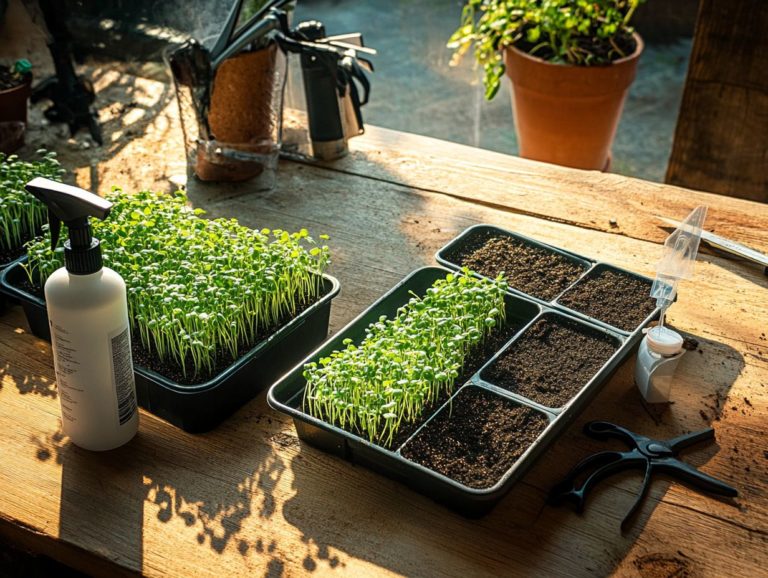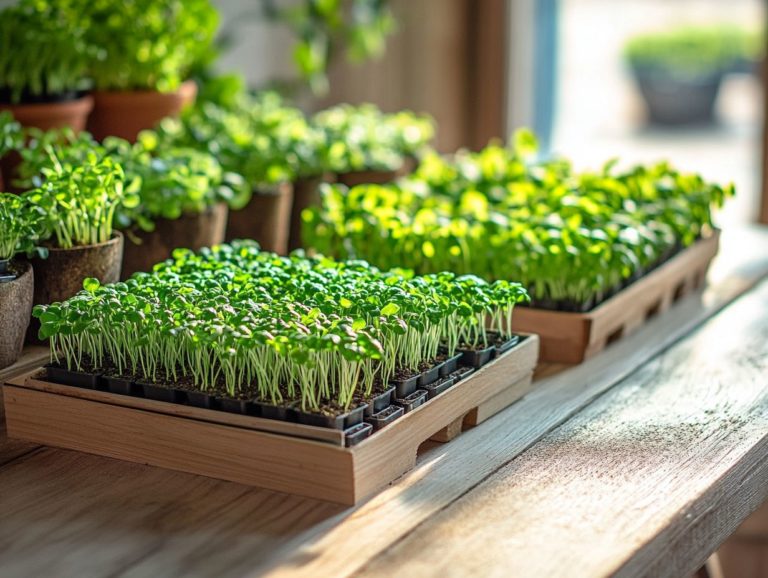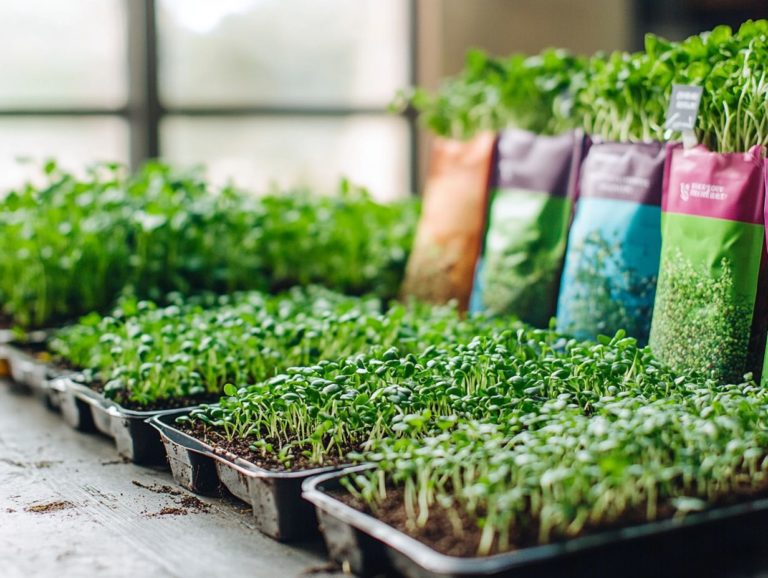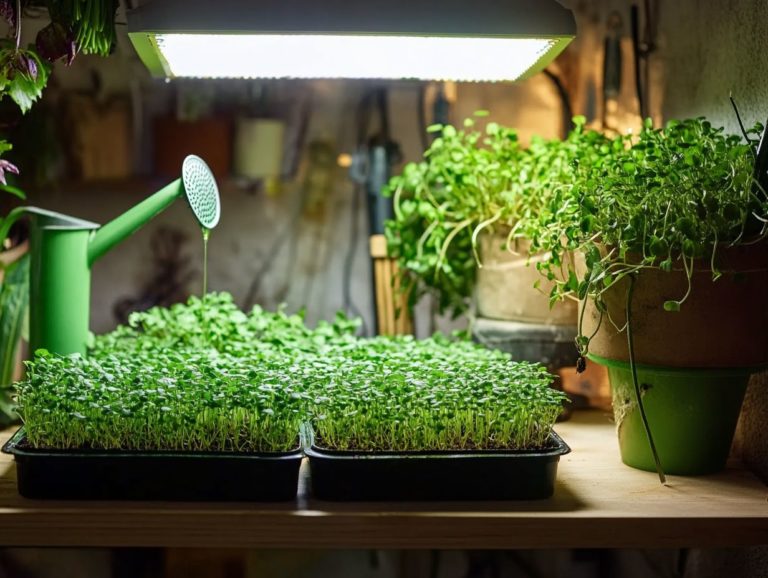5 Best Microgreen Growing Apps
Microgreens aren t merely a trendy garnish; they re a powerhouse of flavors and nutrients packed into those petite leaves.
If you re ready to embark on the journey of growing your own microgreens but find yourself hesitating, the right app can be your perfect companion, effortlessly guiding you through the entire process.
This article delves into what microgreens are and makes a compelling case for why they should find a place in your garden. You ll discover essential factors to consider when selecting a microgreen growing app and explore the top five apps that will help you cultivate these vibrant plants with ease.
Get ready to explore amazing features, benefits, and tips that will kickstart your microgreen journey!
Contents
- Key Takeaways:
- 1. What Are Microgreens and Why Should You Grow Them?
- 2. Factors to Consider When Choosing a Microgreen Growing App
- 3. Top 5 Microgreen Growing Apps
- 4. Features and Benefits of Each App
- 5. How to Get Started with Microgreen Growing Apps
- 6. Best Growing Mediums for Microgreens
- 7. The Importance of Nutrition Levels in Microgreens
- 8. Tips for Successful Microgreen Cultivation
- 9. Common Pests and Diseases of Microgreens
- 10. Harvesting and Storing Your Microgreens
- Frequently Asked Questions
- What are the top 5 microgreen growing apps?
- Are these apps right for you?
- Do these apps provide information on different types of microgreens?
- Are these apps compatible with all devices?
- Do these apps offer personalized tips and recommendations?
- Are there any costs associated with these microgreen growing apps?
Key Takeaways:
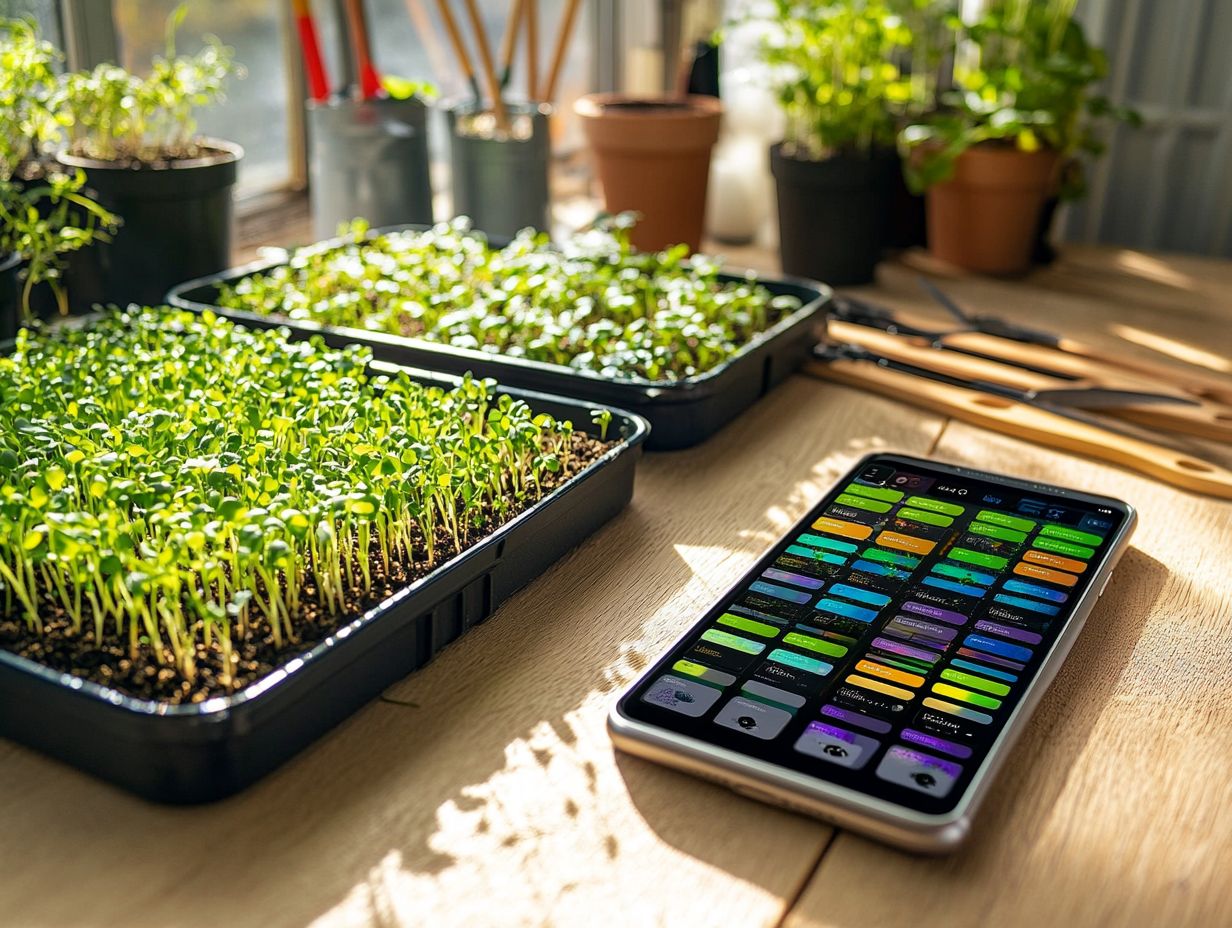
- Microgreens are nutrient-dense, easy to grow, and can be harvested in just a few weeks, making them a great addition to any diet.
- Before choosing a microgreen growing app, consider factors such as cost, user-friendliness, and available features to ensure the best fit for your needs.
- The top 5 microgreen growing apps offer comprehensive guides, informative resources, and helpful features to make growing microgreens accessible and enjoyable for all levels of experience.
1. What Are Microgreens and Why Should You Grow Them?
Microgreens are your gateway to a world of vibrant, edible plants, harvested just after the first true leaves emerge. These tiny greens pack bold flavors and impressive nutrition, making them a fantastic addition to your diet.
Not only are these greens brimming with essential vitamins and minerals, but their concentrated flavors can elevate even the simplest of dishes think salads, sandwiches, and smoothies that burst with freshness. The beauty of cultivating microgreens lies in their rapid harvest times, often ready in just a couple of weeks. This quick turnaround appeals to everyone, from novice gardeners craving immediate results to seasoned horticulturists seeking a splash of variety.
Your choice of growing medium plays a pivotal role in their development. While soil offers vital nutrients, soilless options can enhance drainage, promoting optimal root health. To create the ideal growing conditions, keep a close eye on light exposure, temperature, and moisture levels. Microgreens thrive in warm, bright environments that avoid excessive saturation.
Embracing this convenient gardening venture rewards you with a nutrient-rich harvest right at home, all without demanding too much of your time or commitment.
2. Factors to Consider When Choosing a Microgreen Growing App
When selecting a microgreen growing app, you should consider various factors that can elevate your growing experience, especially if you re incorporating hydroponic systems growing plants without soil, using water and nutrients instead or automated growing methods into your gardening routine. Look for features that support specific seed varieties and ensure compatibility with the right growing trays; these are essential for optimizing your growing conditions and maximizing yield.
A well-designed app not only assists you in seed selection but also streamlines the entire growing process, guiding you seamlessly from planting to harvest. For instance, you might want to explore 5 popular microgreens with easy harvesting for your next project.
You ll find that intuitive user interfaces make navigation a breeze, allowing both novices and experienced growers to quickly access vital information. The app s support for diverse growing systems whether soil-based, aquaponic, or hydroponic offers you the flexibility to choose your preferred method and resources.
Incorporating educational resources like step-by-step guides, troubleshooting tips, and video tutorials empowers you with knowledge to tackle challenges. By adopting this comprehensive approach to user experience, you enhance your satisfaction and cultivate a proficiency in growing vibrant microgreens.
Start your microgreen adventure today and enjoy fresh flavors right from your home garden!
3. Top 5 Microgreen Growing Apps
Finding the right microgreen growing app can truly elevate your gardening experience by offering invaluable insights into best soil options, nutrition levels, and how well seeds sprout. Whether you’re just starting out or have a green thumb from years of experience, these apps are crafted to streamline the cultivation process.
They come equipped with features that support automated systems while guiding you through the intricacies of seed selection and growth optimization.
With user-friendly interfaces and personalized advice, these tools are perfect for both novices and seasoned cultivators. They not only help you determine the best growing medium for various microgreen varieties but also provide nutrition guidelines to ensure your plants flourish, including creative ways to grow microgreens.
You’ll receive tips on boosting germination rates, giving you the power to maximize your harvests and relish in fresh, nutrient-rich greens. Here’s a closer look at the top 5 mistakes in growing microgreens that are making a splash in the gardening community.
4. Features and Benefits of Each App

Each app offers a variety of features that enhance your gardening experience. Whether it s automated systems that streamline operations or comprehensive resources on hygiene practices and seed varieties, understanding these features is crucial for selecting the app that best aligns with your needs.
With this knowledge, you can choose the best soil for your microgreens while ensuring their health and vitality. In this section, you’ll explore 5 key factors for successful microgreen growing, giving you the power to make an informed decision.
These applications typically feature intuitive interfaces that accommodate users of all skill levels. For those new to gardening, the user-friendly design facilitates effortless navigation, enabling you to easily track your progress and implement best practices.
Experienced growers will find value in the detailed analytics and customizable settings, which help fine-tune their cultivation strategies. Many apps also offer informative resources on maintaining proper hygiene practices to minimize contamination risks and optimize crop yields.
Collectively, these features foster a supportive environment for anyone eager to cultivate vibrant microgreens successfully.
5. How to Get Started with Microgreen Growing Apps
Starting your journey with microgreen growing apps is incredibly exciting and rewarding, especially once you grasp the essential elements like selecting the right growing medium and exploring diverse seed varieties. Many of these apps come equipped with comprehensive guides tailored for beginners, including thoughtful recommendations for potting soil and automated systems designed to simplify the planting and maintenance process. With the right guidance, you can cultivate vibrant microgreens with minimal effort and maximum enjoyment.
To kick things off, it’s crucial to set up the app you choose properly, ensuring it aligns perfectly with your gardening goals. Once it’s up and running, you’ll dive into exciting soil options that promise amazing results, such as coconut coir or soil blends that optimize root development. For those interested in herbs and vegetables, learning about the best ways to grow and store microgreens can also be incredibly beneficial.
After settling on a medium, the next step is to pick your seed varieties; starting with easier options like radish or sunflower can yield quick results. By attentively following the app’s recommendations, you’ll not only encourage healthy growth but also navigate common challenges like pest control (which means keeping unwanted bugs away) or inconsistent moisture levels with ease. Additionally, implementing the 5 best practices for harvesting microgreens will ensure you maximize your harvest effectively.
6. Best Growing Mediums for Microgreens
Choosing the right growing medium is essential for successful microgreen cultivation. It directly influences drainage, water retention, and nutrient availability.
You have a range of options soil, coco coir, hemp mats, planting mixes without soil, and peat moss each offering unique benefits tailored to various types of microgreens. By understanding the characteristics of each medium, you can optimize growth conditions and enhance your overall yield.
Take soil, for instance. It s packed with rich nutrients and beneficial microorganisms. However, if you re not vigilant, it might invite unwanted mold growth.
Coco coir is another excellent choice. It retains moisture beautifully and encourages healthy root development, though you’ll need to ensure proper fertilization to meet nutrient needs.
Hemp mats are a sustainable and convenient option, offering good drainage and aeration. However, they can come with a higher price tag.
Planting mixes without soil are versatile and lightweight, perfect for rapid growth, yet they may require more frequent watering.
When selecting your medium, consider the specific seed variety, light conditions, and available space. Properly preparing each medium whether by soaking coco coir to hydrate it or spreading soil evenly can significantly impact your chances of achieving a bountiful harvest of microgreens.
7. The Importance of Nutrition Levels in Microgreens
Nutrition levels are crucial for the successful growth of microgreens. These tiny plants thrive on a well-balanced nutrient blend that supports their rapid development. By ensuring proper water retention and adhering to hygiene practices, you can enhance germination rates and promote healthier plants.
Understanding the nutritional needs of different microgreens allows you to tailor your feeding strategies for optimal results. To create an effective nutrient blend, consider combining organic fertilizers with essential micronutrients. Adjust the mixture according to the specific variety you re cultivating.
Keep a close eye on soil moisture levels to ensure your plants flourish! Both overwatering and underwatering can adversely impact growth.
Cleanliness is also key. Regularly sanitizing trays, tools, and your growing environment minimizes the risk of diseases and pests that could hinder your plants’ development. By implementing these best practices, including 5 tips for quick microgreen harvests, you can cultivate an environment where microgreens thrive, ultimately reaping a bountiful harvest rich in flavor and nutrition.
8. Tips for Successful Microgreen Cultivation
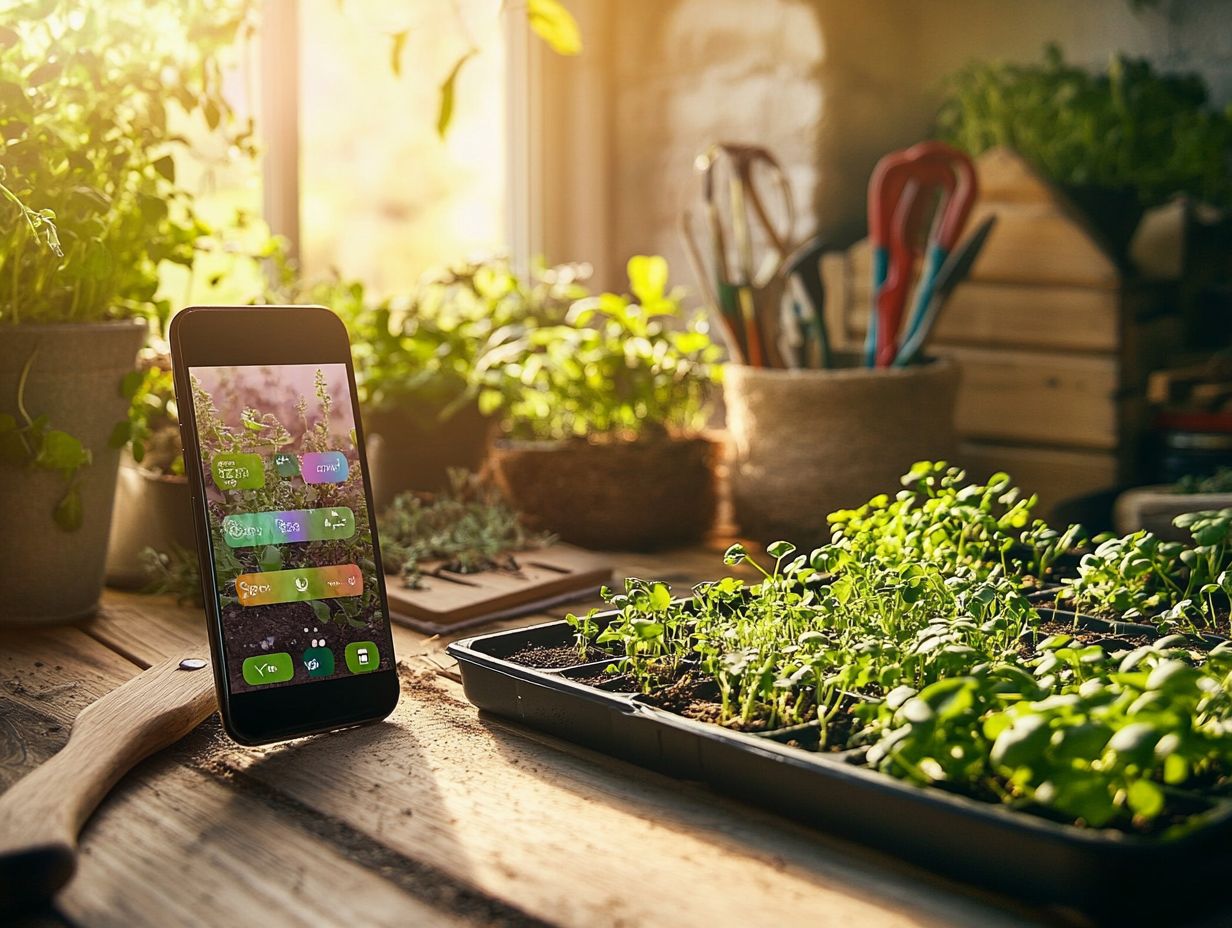
Successful microgreen cultivation rests on several essential practices that promote high germination rates and vigorous plant growth. Proper hygiene and thoughtful seed selection are paramount.
By utilizing automated systems, you can elevate your growing process, ensuring consistent moisture and light levels. Implementing these strategies will lead to healthy, thriving microgreens that offer both flavor and nutrition.
Start by soaking your seeds for several hours before planting. This simple yet effective step can significantly enhance germination rates by allowing the seeds to absorb the moisture they need.
Maintaining optimal light conditions is vital. Microgreens flourish under fluorescent or LED lights positioned approximately six inches above the seedlings.
Don t underestimate the significance of hygiene. Clean tools and surfaces are your best defense against diseases, ensuring your crop s success.
Embracing automated systems not only streamlines watering and lighting but also enables you to set specific schedules tailored to the unique needs of various microgreen varieties. For instance, consider the top 5 microgreens for easy harvesting, which can significantly enhance your results.
9. Common Pests and Diseases of Microgreens
Recognizing common pests and diseases that affect your microgreens is crucial for creating a healthy growing space and ensuring robust yields. By implementing effective hygiene practices and preventive measures, you can reduce these threats and safeguard your microgreens from infestations and diseases. Understanding the signs of potential issues gives you the power to take proactive steps for nurturing healthy crops.
Microgreens are delicate and vibrant. They can easily fall victim to pests like aphids, spider mites, and whiteflies, especially in warm, humid conditions.
Diseases such as damping-off (caused by fungi) or downy mildew can swiftly harm your plants if not identified and managed quickly. Regularly inspecting your crops for unusual discoloration or wilting leaves can help you catch these early warning signs of trouble.
By maintaining cleanliness in your growing area and rotating your crops, you can significantly reduce the risk of infestations and diseases. This creates a thriving environment that fosters healthy growth and maximizes your yield potential.
10. Harvesting and Storing Your Microgreens
Harvesting and storing your microgreens with precision can profoundly influence their nutritional levels and flavor profiles, ensuring you experience them at their finest. Knowing the optimal time to harvest and employing the right techniques will help you preserve their freshness and enhance their culinary qualities.
Understanding effective storage methods is key to keeping your microgreens fresh after harvesting.
To ensure peak flavor and nutritional value, watch for signs like vibrant color and the appearance of true leaves the first leaves that show up around 7 to 14 days after germination. When your microgreens reach about 2 to 3 inches, it’s the perfect time to harvest! Their taste is at its most concentrated.
After harvesting, place them in a breathable container lined with a damp paper towel to maintain moisture levels. Storing them in the refrigerator will extend their shelf life. By following these tips, you can truly savor the delightful experience of fresh microgreens in every meal.
Frequently Asked Questions
What are the top 5 microgreen growing apps?
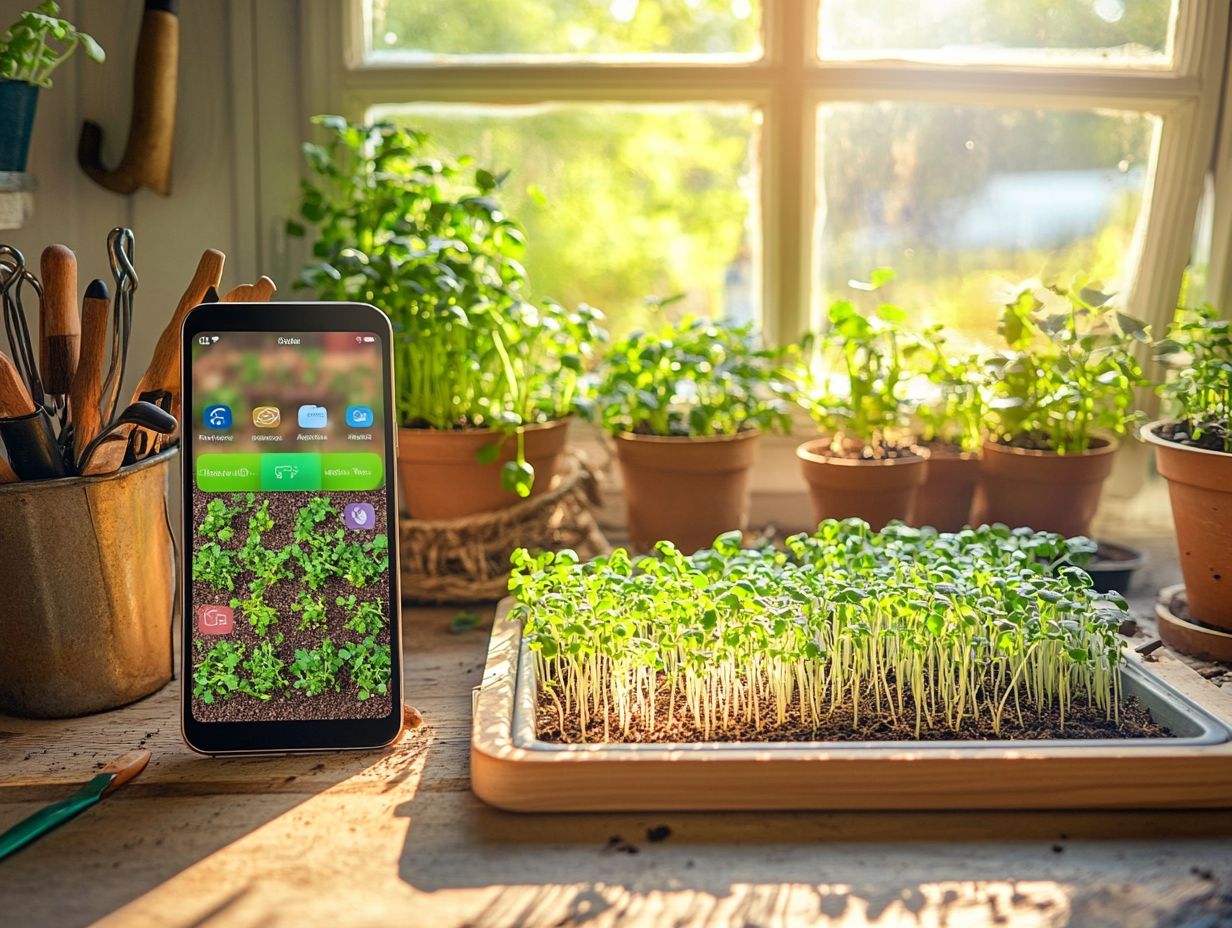
The top 5 microgreen growing apps are Microgreens, Sprouts, GroCycle, Seedo, and Planted.
Are these apps right for you?
Yes, these apps cater to both beginners and experienced growers with various features and information available.
Do these apps provide information on different types of microgreens?
Yes, these apps include a wide variety of microgreens and provide information on how to grow each one of them.
Are these apps compatible with all devices?
Yes, these apps are available for both iOS and Android devices, making them accessible to a large number of users.
Do these apps offer personalized tips and recommendations?
Yes, these apps use data analysis and user input to provide personalized tips and recommendations for optimal microgreen growing.
Are there any costs associated with these microgreen growing apps?
Most of these apps offer free versions with limited features, but there are also paid versions with more advanced features available for purchase.

